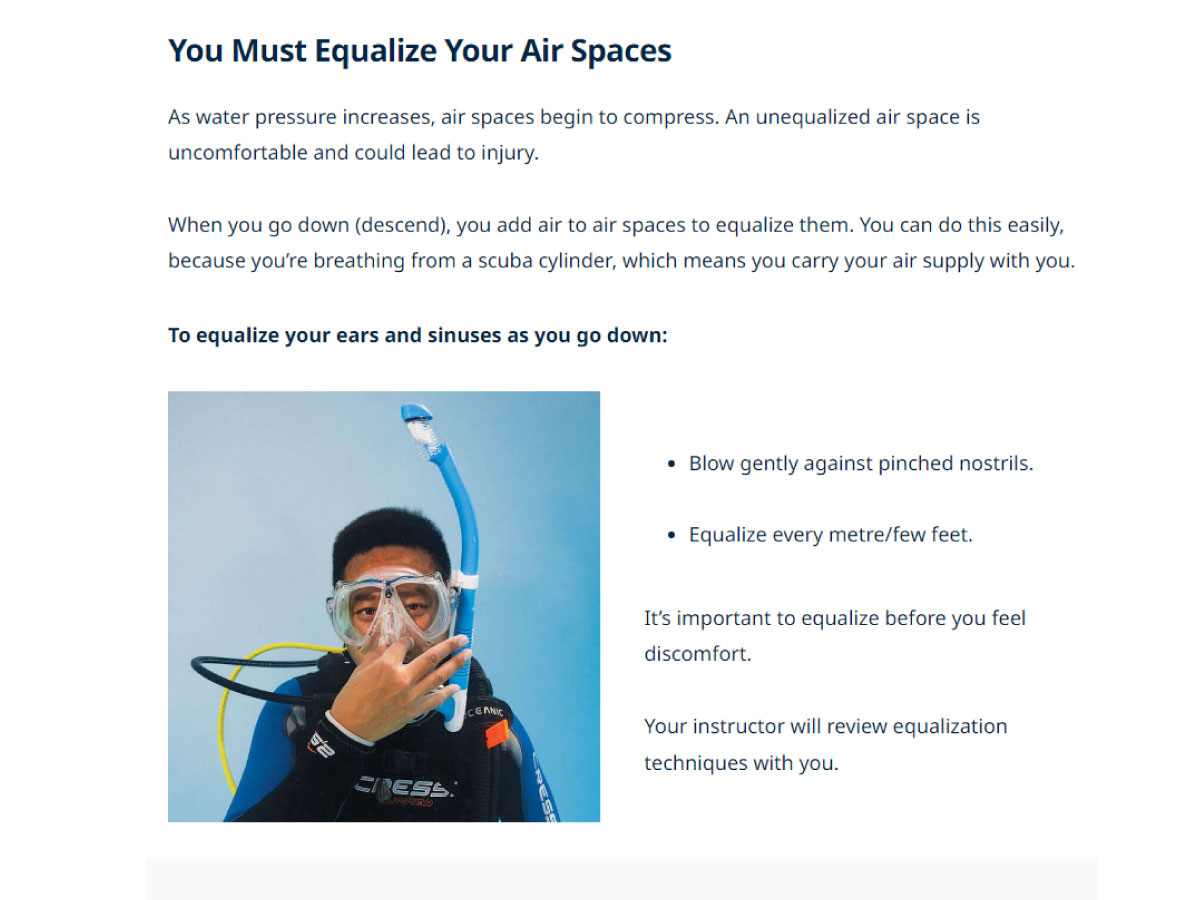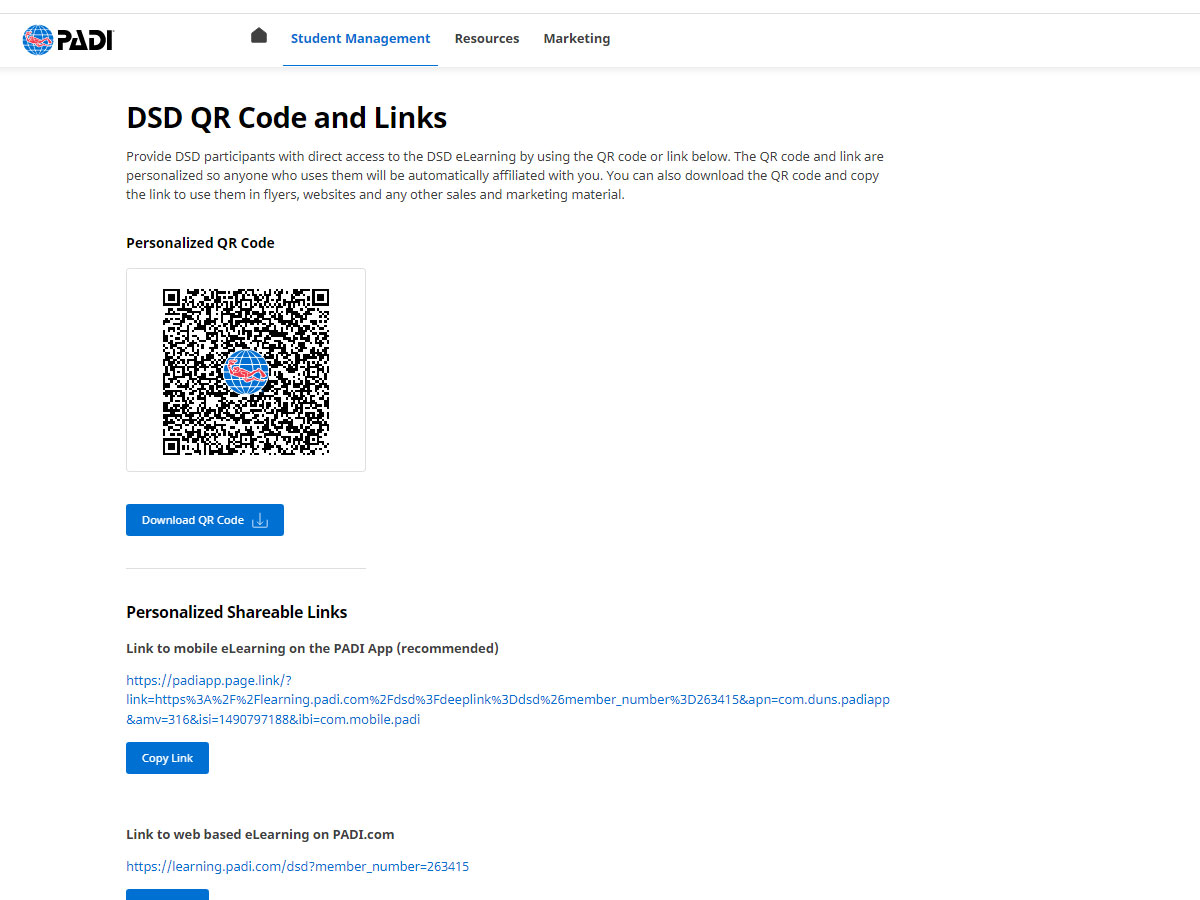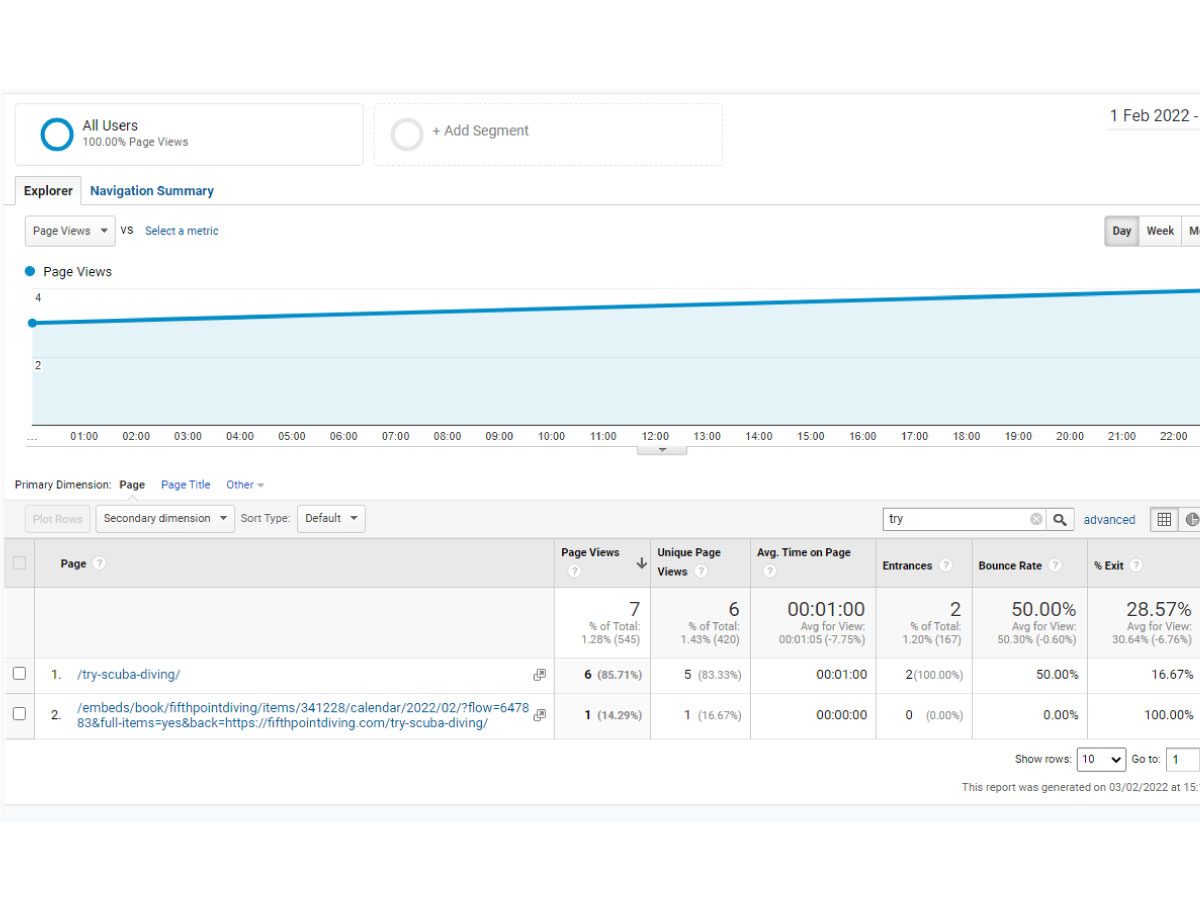SELL MORE DSDs
GET CREATIVE WITH PADI'S BRAND NEW DSD ELEARNING
PADI have just dropped a brand new product.
And it's AWESOME.
At first glance, you might think it's just another elearning product added to their catalogue.
But take a closer look because this DSD elearning is SOOO much more than that!
For starters, it's great that our DSD participants are going to turn up with prior knowledge and understanding. This is going to help improve the customer experience because we can change the way we teach that (sometimes boring) "classroom" bit.
It also gets the customer doing the hard work when it comes to data entry - no more copying names and addresses into the OLPC when you're processing certs as the student does that bit for you! This will be great news to dive centres who do hundreds of DSDs each month.
But the coolest thing you can do with the new DSD elearning (and a little bit of creativity) is to use it as a lead magnet.
If that's a term you're not very familiar with, don't worry - it's marketing jargon! In this article, I'm going to explain what the new DSD elearning is, shine a light on lead magnets and give you 5 ways you can use this new product to generate more DSD sign-ups.
What is the new PADI DSD elearning?
I must admit, PADI are really starting to hit the nail on the head with their elearning.
If you're a salty sea dog like me, you might have watched this digital evolution through the years. It started out pretty boring with limited interactivity. Then it morphed into the touch products that looked amazing, but were SO overly interactive they were hard to use and had huge download sizes. Currently, they've found the happy medium between the two. The elearning looks slick, is easy to use and it's as engaging as online learning can possibly be.
The whole ethos of the Discover Scuba Diving program is to get people in the water and having fun as quickly as possible.
DSD elearning is going to help us do that even better. It's going to cut down on classroom time as participants will already have some knowledge. We just need to check that learning, meaning our briefings can be much more interactive and discussion led.
While that style of teaching has the potential to be a whole blog series in itself, there's no doubt in my mind that teaching this way improves quality of training and customer satisfaction. If you use DSDs as a stepping stone for an Open Water Course upsell - you need to get this bit right!
In a future blog, I'm going to explore this in more detail and it's definitely a hot topic in the diving industry right now. I'm a massive fan of Darcy Kieran's work at Scubanomics and I'm really looking forward to the results of his latest survey that asks "How would you rate the quality of your Open Water Diver course or Discover Scuba Diving adventure?"
As soon as these results come out, I'll be evaluating the way we deliver our DSDs at The Fifth Point and making them even better. Incorporating the new DSD elearning is definitely going to be a massive part of this so watch this space, I'll be writing all about it!

(Eww... we've certainly come a long way since the old style DSD elearning!)
Okay, lets look at the NEW DSD elearning product.
On the front end, the new DSD elearning looks the same as all the other PADI digital products right now. Students access it from that drop-down menu in their app or browser dashboard. After working through text, images and videos, they answer interactive questions to check their learning. The whole process from sign up to knowledge review should take about 30 minutes.

I've been playing around with it in the back end, and there's a couple of things you need to know. There's pretty big changes here. It does look very different and there's obviously lots of hard work going on behind the scenes to improve the processing side for PADI pros.
The good news is that they're going to cost the same as whatever you're paying now for your paper booklets. I was so relieved when I saw that because even though I love elearning - particularly for carbon footprint savings, it winds me up that a digital product can end up being more expensive than a physical paper manual.
You buy them in the same place as you do now - so whether that's through the online shop or from your rep at PADI, nothing's changing there.
But when it comes to using these codes, you don't use the normal OLPC. So that place where you're assigning all your other elearning codes, managing your current students and processing certs - that's not where you're going to use for DSDs with this new elearning.
There's a whole new processing place and PADI have informed me that eventually, everything will be done through this new style system. I know it's another change. There's been LOTS in the last year or so when it comes to the new look PADI Pro login (is it just me or were there a few months where literally every time I logged in, the menus layouts changed?!) But honestly, stick with this one because it's going to be great.
Instead of entering the student's name, email and date of birth and triggering an email to be sent to them, you simply send them a personalised link or QR code. Amazing - and more on this in a minute.
Once your student has signed up, to see them you need to be in your pro dashboard. Go to Student Management > Manage Students > DSD Participant Management.

The new processing area is much slicker. It gives you important information like "do they need medical clearance" at a glance (FINALLY!) and when it comes to processing students, it's so much easier.
If you want to see a walkthrough of how to assign codes, process students and the flow that your customers will see, PADI did a great webinar on it earlier this week. You can watch the recording here.
What is a lead magnet and how will it help bring in new divers?
A lead magnet is marketing jargon for something that you give away for free in return for collecting someone's contact details. You can then follow up with them and try to convert them into paying customers.
Lead magnets come in all different forms - a helpful PDF guide, a short video, a free webinar, an ebook, an editable template... there's no end to how creative you can be with a lead magnet.
The one thing they all have in common is that they're something juicy that your potential lead can't wait to get their hands on, but they can't access it until they've filled in a form with their contact details. Typically after that step, the lead magnet is emailed to them or they're redirected to the place where they can see it.
The next step is the most important - you have to follow up with them! What's the point in putting all this time and effort (and possibly money too) to collect these potential leads if you're not going to do anything with them?
Making a lead magnet from scratch takes a lot of time. If you want to see a working example, take a look at the calculator I created for aspiring instructors to find out exactly how much their IDC is going to cost. This took me about 12 hours to create from start to finish, along with all the Facebook marketing content I made too.
Here's the steps you'd need to go through to make your own lead magnet from scratch:
- You have to create the PDF, record the video, write the ebook - whatever it is you've chosen to use, you have to make it.
- You need to create a landing page (a simple website page) that explains why they should give you their details in return for this juicy thing. You need to write about why it's irresistible. It's essentially a mini sales page and even though you won't be charging them any money, they're paying with their contact details so it still needs to convert.
- You have to build the form on the landing page - the place where they enter their contact details which then notifies you each time it's been completed.
- You need to have processes in place that delivers the lead magnet to them - what happens when they click the "submit" button on the form? Is there an automated email that delivers the lead magnet? Are they redirected to another webpage with further instructions?
- You need to advertise the lead magnet - you need to get eyes on this juicy offer. This could be through your social media or your email lists but if you truly want to get in front of new customers, you might need to think about paid advertising which comes with its own set-up challenges and of course, cost.
Now then, you're probably sitting there thinking "how the hell am I supposed to do all that?!" "Why is Nic banging on about this, it's a waste of my time!"
BEAR WITH ME!
With the new DSD elearning, PADI have dropped a finished lead magnet right in your lap.
It's already set up as a juicy freebie that people will want, it already captures their contact information and notifies you and it takes care of delivering the product to your potential lead. All you need to do is get eyes on it and follow up with signups.
They've even made it easy to share your lead magnet, and you don't necessarily need to use paid advertising to get it out there either - every dive centre or PADI member has access to their own personalised QR code. You can display this ANYWHERE and EVERYWHERE you can think of. People see it, scan it and are immediately taken to the PADI app to register for their DSD elearning.
You can access your customised QR code from your PADI Pro dashboard. Go to Student Management > Manage Students > DSD QR Codes and Links.

But won't I have to pay for everyone who signs up? What if they never show up at the dive centre?! My initial thoughts too! So, yes - you will have to fork out a bit of cash initially to have a float of codes that people can access. What is REALLY cool (and something PADI have only just recently cottoned on to, unlike RAID who have been doing this forever) is if this person never shows up, if you never hear from them again - you can reclaim the code to give to someone else.
BOOM.
An evergreen lead magnet that utilises stock that you'll always end up using anyway. No wasted money!
This could seriously be a game-changer to your marketing efforts. You need to get this QR code out EVERWHERE and that's going to take a little bit of creative thinking.
5 places you can get eyes on your QR code and get new DSD leads
To get the creative juices flowing, I've come up with 5 marketing ideas that we'll be rolling out at The Fifth Point. This is literally a work in progress - the new DSD elearning was only released last week so I'm designing and creating as I type this. If you keep an eye on our social media over the next month or so, you'll watch it roll out live!
1. On promo leaflets
If you already have leaflets that you give out or posters on display, get the QR code pride of place on everything you class as promo material. If you've recently done a printing run, or have lots of existing stock that you can't bring yourself to throw away, it might be an idea to get some stickers printed so you can add it easily without waste.
BUT, if you're going down this route of reusing with stickers or adding into existing designs and reprinting - take a step back first and analyse your materials. Does it stand out enough or is it lost amongst all the other information? Is it clear enough to understand what the QR code is for and what they get? Does it really do justice to this amazing product that they're going to get for FREE?
If the answer is no, a little investment in a new, more specific design will be money well spent.
A specific leaflet, poster, or maybe even a business card style design that is just for promoting this free DSD elearning lead magnet would be ideal for this lead magnet.
It can sit somewhere prominent in the dive centre, on a table at an event you're attending, keep a stash in the dive van for when people ask you questions at dive sites. It would also be great to dish out to your team and existing customers as a cool little coupon to pass to anyone who might be interested.
The QR code leads to an actual, real, valuable product. It's worth something to anyone who's thinking about getting into diving. Make a point about it! Use it like it's a special gift and you're giving it to a potential customer to show that they're valuable to you.

2. On roller banners
Having your personal QR code on a roller banner is similar to a poster except they're usually bigger, they're more easily transported (they come in their own carry case and there's no way they can get creased or bent) plus you can pop them up pretty much anywhere!
I usually design specific roller banners for different purposes so that depending on where we are, we can pop up a targeted message and advertise to a more specific audience. They're cheap, they look class, they stand out and they last a long time (until heavy-handed Harry gets hold of one that is...hah!)
For example, we'll be promoting at the Banff Mountain Film Festival next month. I'll be designing a roller banner with a call to action to scan the QR code and start their diving adventure in the interval instead of munching on popcorn.
A perfect place for a roller banner would be poolside - especially if you always get lots of people watching and wondering what you're up to! Your message could be something like "This could be you next week! Scan here and get started right now!"
One downside of the cheaper roller banners is that they aren't great for outside use. You'd need to have something a bit sturdier if you wanted to advertise at outside events or dive sites. A vinyl banner that you peg up somewhere or a flag might be a good alternative.

3. On your dive centre van
Our dive van has always been a great source of advertising for The Fifth Point. So many people say "I saw your van - I never even knew you existed!", "I saw it in ASDA car park" or "I saw it at the beach and wanted to get in touch".
Full van wraps are a hefty investment, it just so happens that I've been putting off wrapping our newest van because of the cost. I'm kinda glad I did because when we do get round to it, the QR code and a call to action could well be a prominent feature in the design.
Of course, it doesn't have to be a big job like a full wrap. You can get awesome magnetic prints that stick on the side of vehicles, plus smaller vinyl cuts for back doors and windows would be much more affordable.
Instead of people spotting your van, snapping a photo for later which they'll more than likely forget about, the QR code prompts them to take action and interact right there and then (assuming they're not driving of course!)
4. On your DSD website page
Have you ever looked into your bounce rates for your website pages? That's people who've come to have a look at your Discover Scuba Diving offering and then left without doing anything. You can find the data in your Google Analytics Console.
Right now the bounce rate on our DSD page is about 50% which I'd say is a little bit above average (although there's no specific data for the diving industry, the PADI.com website currently sits at about 47%).

It doesn't actually matter what your bounce rate is compared to others, what matters is that you see an improvement and a decrease in that percentage when you make changes to the copy and call to action on the page.
Ideally, I want my DSD page to convert for bookings - I want people to land on the page, like what they see and then click to book and pay. Because of this, I probably won't put the QR code on the DSD page because I don't want to dilute my booking conversion with another call to action. Really, there should only be one call to action per page.
BUT, if you don't have any way of taking bookings on your website right now, you'll probably find that your bounce rate is quite high. If you have no way for the viewer to interact with your page other than being redirected to a "contact us" section, they'll bounce off the page quickly. Adding your QR code (or perhaps the link that you can also get from your dashboard which might work better on a website) will be the perfect way to engage your viewers, improve your conversion rates and lower your bounce rates for the page.
Before you make the changes, make a note of your bounce rate percentage. Revisit the stats in a couple of months and see if it's improved!
Just because I'm not putting the QR code on my DSD page, doesn't mean that it won't feature on my website at all. In a similar way to my idea for a specific leaflet for this campaign, I'm going to make a digital leaflet - a landing page.
Like my other lead magnet landing pages (here's another example, this time for an ebook to help choose the best wetsuit for UK diving from my other company The Honest Diver Supply Co) it'll be a short sales page, but this time I won't need to worry about having a form on there. It'll just have the link to the DSD elearning because collecting details is all taken care of by PADI.
I can now point eyes towards this landing page in blog posts, social media posts, email marketing etc. etc.
5. On social media
Who doesn't love a free giveaway on social media, and you can use this new DSD elearning for exactly that. Get your thinking caps on for this one and see how you can most creatively use this opportunity to directly get leads, but also to generally grow your social following.
It could be a simple post like "click here to get your free elearning", but that doesn't do much in terms of engagement and actually, social media alogrythms tend to punish posts that include outside links in them. They don't want people to leave the platform so won't show your link to as many people to stop that from happening (and to make people more likely to pay for advertising so that people will see the link).
Think outside the box - can you turn the codes into a giveaway, run a competition... there's loads of things your can do.
I'm even toying with the idea of putting some paid advertising behind this one. I'll be honest, my Facebook adverts used to perform really well. And then Apple put a spanner in the works when they changed their IOS and privacy stuff. It essentially meant that adverts on Facebook (and other digital marketing platforms) would not reach Apple users because they couldn't be tracked online anymore.
Since then I've felt like all the money I've spent on paid advertising has been wasted because I've not seen any significant returns.
I am tempted to try again with the DSD elearning though. I think it might be successful as it's an actual PADI product - not just a lead magnet that I've created myself. It's got a big brand label on it. I wouldn't even need a landing page in this case either - the Facebook ad would point directly to the elearning download link, making it a very simple ad to set up.
I might chuck a couple of quid behind it - at this point, I feel like paid advertising is pretty much gambling anyway, so it might be worth a punt!
So, what do you think?
I'm sold on the new DSD elearning.
I think it's going to be great from a teaching perspective, great from an admin perspective and even better from a marketing perspective.
PADI create amazing marketing resources for dive pros every day. They're made even better when we can be creative with them.
There's no point reinventing the wheel. Making your own lead magnets is time-consuming and there's never a guarantee that they'll be successful.
With the new DSD elearning, you've got a ready-made lead magnet right in front of you. Run with it, use it in imaginative ways, test, tweak and see if it brings in new customers.
Good luck and let me know how it goes!